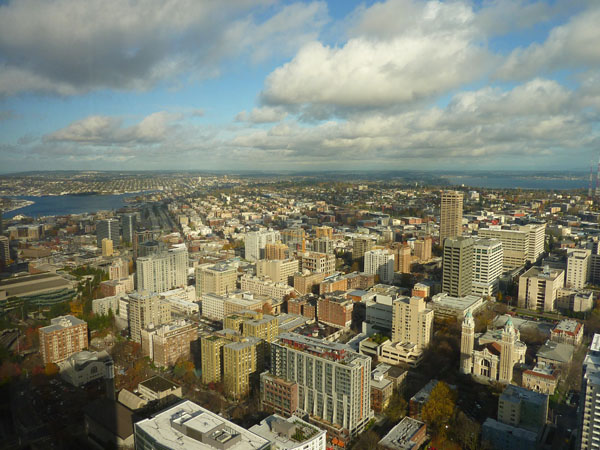The Goal Thing

[ Mike McGinn at an ambassador meeting, clearly enjoying the outreach process: It’s a good sign. ]
Seattle Mayor-elect Mike McGinn kicked off his transition with a call for input from the public on three questions:
- How do we build the strongest possible team to achieve the policy objectives and values set forth by the campaign (grass roots community involvement, transparency and neighborhood focus)?
- How do we build public trust in the new administration?
- What do you view as the incoming administration and the city’s greatest challenge – what should we do first out of the gate?
I’ll start with question number three, because in the end it all comes down to action.  But before we can act, we first must have an inspiring purpose—we must have goals.  And so pulling back to the big picture view, my take is: Establishing transcendent goals is both the greatest challenge, and what must been done first out of the gate.
Setting goals is challenging because a good goal must be many things: uplifting and compelling, galvanizing and uniting, lofty, but not too lofty. A good goal can’t be too vague or open to interpretation—goals must have measurable outcomes against which success can be gauged. And the best goals have broad implications and percolate out across multiple realms—they’re game changers.
At a Town Hall lecture two weeks ago Alex Steffen proposed a goal for the City of Seattle:  achieve carbon-neutrality by the year 2030. This is the right stuff. Of course the main objections would be that it’s too aggressive, and would require too much sacrifice. But closer analysis reveals that pursuing this goal would lead to greater prosperity for all in the long run. And aiming high is better than aiming low.
Mayor Greg Nickels recently proposed another excellent goal: Seattle will become the most walkable city in the nation. The City made a laudable first step toward that end with the production of a new Pedestrian Master Plan, but unfortunately the dedication of funding for implementation has fallen far short of what is needed.  The overt statement of a goal provides ammo for pedestrian advocates to keep up the pressure on electeds, but more importantly, it is what set the whole process in motion. Which is why setting goals right out of the gate is so important.
>>>
With a set of goals in place, the issue broached in question number one—building a team—becomes more focused. You bring on leaders who have demonstrated that they passionately believe in your goals. And those who don’t most likely won’t want to be on the team anyway.
And since meaningful goals for the City almost invariably draw from multiple disciplines and city departments, the most successful team will be comprised of leaders with a strong interdisciplinary mindset, who thrive on open collaboration, who have the intellectual bravery and curiosity to learn outside their usual boundaries, and who can see the big picture. The “silos” of isolated practice within City government must be dismantled if we hope to have a shot at the challenges we face. And I would go so far as to say it calls for a dedicated team within the administration: The Silo Busters.
>>>
So that leaves question number two—what about trust? Trust takes time—it can’t be rushed. Certainly the “open-source transition” will help, though real trust will only come when people see the administration act on the input they get from the public.
In the mean time, an established set of goals can help build trust. Because when people buy in to the goals, they’re less likely to be suspicious of every move the administration makes. If people can see the long game, they’ll be more inclined to put their trust in proposals that might otherwise seem too burdensome based only on the myopic view.
There’s also a flavor of trust that people grant to bold leaders. And I would put forth that the residents of Seattle are starving for bold leadership. The immense and escalating challenges the City faces—economic, social, and environmental—are widely recognized, and the cause of not a little angst among Seattle residents. If the new Mayor can show that he recognizes these grave concerns, and that he has appropriately bold goals for how to address them, I suspect we may hear a surprisingly loud collective sigh of relief.
>>>
So what then, are the right goals for Seattle? What does Seattle want to be?
In the broadest sense, Seattle must become a sustainable city fit to thrive in the 21st Century.  And it is critical to emphasize that sustainability means a better life for everyone.
I would argue that we already know the ingredients of the sustainable city we want. There are numerous existing models that demonstrate the key pieces (though none have pushed them as far as they need to go). There has been an exhaustive amount of research and an exhausting amount discussion. By now it’s a familiar list to anyone who’s been paying attention: affordable housing, equitable public schools, a resilient economy, green jobs, energy and resource conservation, carbon neutrality, pollution and waste reduction, compact development, a vibrant public realm, extensive transit, safe streets, efficient delivery of public services, cohesive neighborhoods, an engaged citizenry, diversity in all of its expressions, and equitable access to all the City has to offer.
All that’s missing is the follow through. And that starts with a translation of what we want into an explicit, inspiring, and visionary set of goals.Â

[ The view from the 60th floor of the Seattle Municipal Tower:Â What does this city want to be? ]
